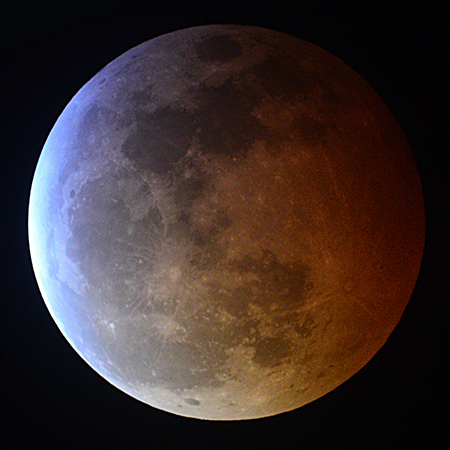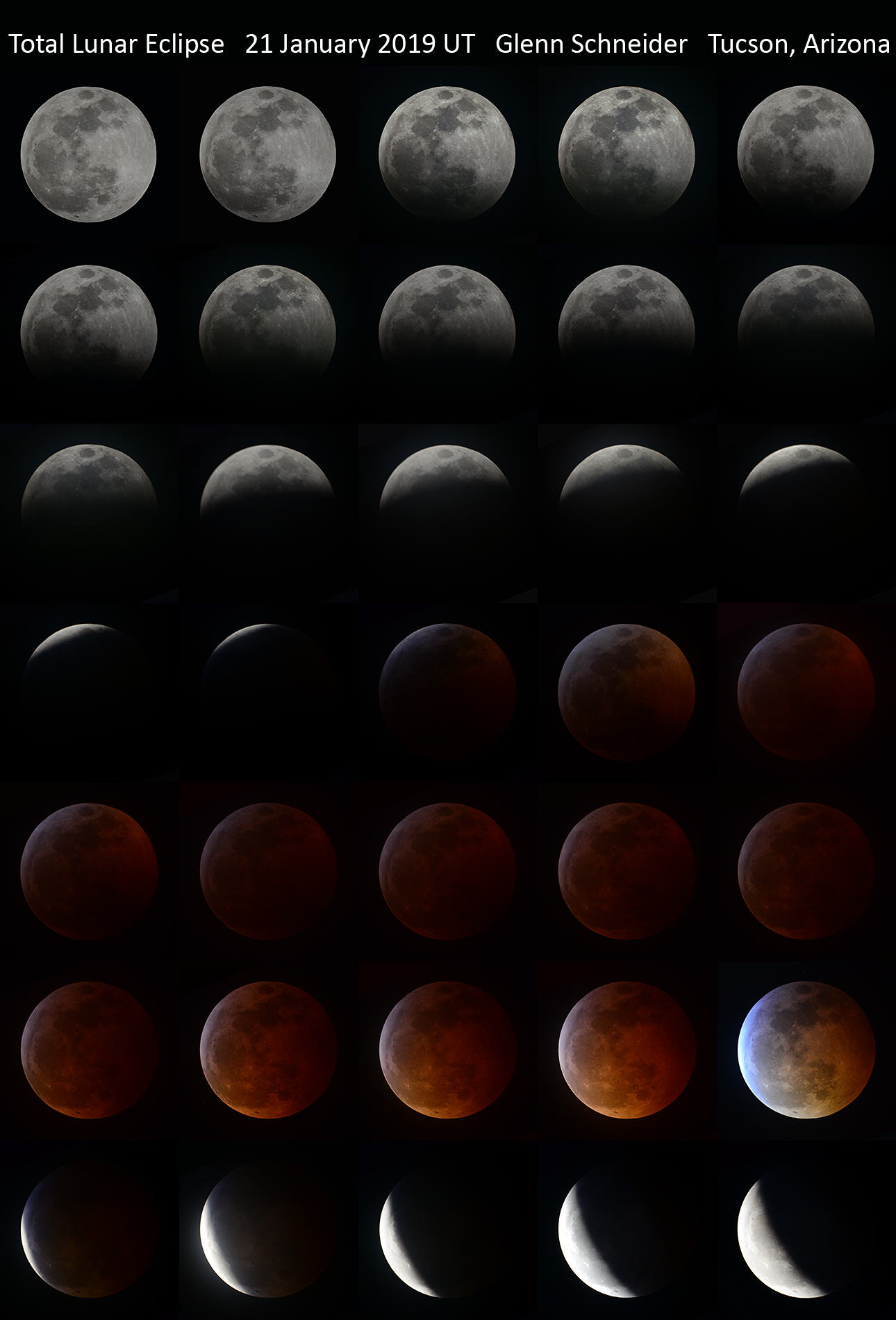 |
Total Lunar Eclipse 21 January 2019 UT Tucson, Arizona USA Glenn Schneider (Steward Observatory and the Department of Astronomy, The University of Arizona) |
 |
The
Total Lunar Eclipse (TLE) of 21 January, 2019 UT was visible to all of
North and South America, and conveniently timed so wrapping up its
partial phase egress with the Moon high in the sky (74°) before
local midnight from Tucson, Arizona – where I watched and photographed
the
eclipse from behind my house. The viewing conditions were less
than stellar (no pun intended). The sky was cast with a hazy,
lingering,
inhomogeneous veil of semi-transparent broken cloud. Temporally and
spatially variable in opacity from horizon to horizon. This was
well
caught in this wide-field
"grab shot" photo by my neighbor with his cell phone camera
taken 17 minutes after 1st contact with the moon overexposed to best
reveal the clouds. (Note the presence of a 22° radius lunar
halo indicative of light-scattering ice crystals aloft. This halo
persisted nearly all night except close to and during totality when the
illuminating moonlight became to feeble for it to be seen). In a
word **schmutz** everywhere scattering the moonlight, lowering
contrast, and
just being plain annoying. BUT...
not at all 'fatal', as quite often it was quickly moving with breaks,
and sufficiently thin to view through, though much lowering the
sky/moon contrast while also acting as an attenuating filter.
Nonetheless,
this was a very 'pretty' and colorful eclipse (especially when viewed
in 7x50 binoculars) despite the sky conditions.
I captured the progression of the eclipse in a photographic sequence (below, top left to bottom right) with a nominal cadence averaging one frame every five minutes, except for the first four frames. The variations from strictly 5 minute centers in the time sequence was due mostly to intermittently interfering clouds. See below the 5x7 mosaic of lunar images for photographic details. The first (upper left) image is of the full moon early in the penumbral ingress phase of the eclipse (20 minutes after the penumbral ingress began). I had hoped for one just prior to penumbral ingress, but clouds in that region of the sky had other ideas. The second photo taken 10 minutes later when a subtle relative amorphous darkening at the 'bottom' of the Moon could be perceived visually. The third photo was just two minutes before 1st contact (the start of the partial phase ingress), and the fourth frame at 1st contact - and then the time-averaged 5 minute sequence begins. The eclipse was photographed through all of partial ingress, totality, and into the first 24 minutes of partial egress. Then, with a combination of a camera glitch, and increasing cloud opacity (best 2 out of 3 for Murphy's Law), I called it quits and just watched the rest with eyeballs and binoculars.
I captured the progression of the eclipse in a photographic sequence (below, top left to bottom right) with a nominal cadence averaging one frame every five minutes, except for the first four frames. The variations from strictly 5 minute centers in the time sequence was due mostly to intermittently interfering clouds. See below the 5x7 mosaic of lunar images for photographic details. The first (upper left) image is of the full moon early in the penumbral ingress phase of the eclipse (20 minutes after the penumbral ingress began). I had hoped for one just prior to penumbral ingress, but clouds in that region of the sky had other ideas. The second photo taken 10 minutes later when a subtle relative amorphous darkening at the 'bottom' of the Moon could be perceived visually. The third photo was just two minutes before 1st contact (the start of the partial phase ingress), and the fourth frame at 1st contact - and then the time-averaged 5 minute sequence begins. The eclipse was photographed through all of partial ingress, totality, and into the first 24 minutes of partial egress. Then, with a combination of a camera glitch, and increasing cloud opacity (best 2 out of 3 for Murphy's Law), I called it quits and just watched the rest with eyeballs and binoculars.

Photo
details: The images above were taken with a vintage clock-driven
(tracking) Questar 3-1/2 telescope (f/14 back focus) with a Nikon D800
camera very kindly on loan to me from eclipse-chaser Joel
Moskowitz.
Occasional tracking corrections were needed as the drive runs at a
sidereal, not lunar, rate. The camera was operated (exposures triggered
"manually", not pre-timed because of the intermittent presence of
clouds) but via a computer-to-camera USB interface control to set
exposure
parameters and fire the shutter for each frame without touching the
camera/telescope. The exposure log below gives the
UTC, and exposure duration (in seconds). The row/column location
of the exposure log entries, corresponds to the row/column position of
the images in the above mosaic. Exposures 1-18 and 31-35 were
taken at ISO 800, those in the log indicated with an X (exposure
numbers 19-30, during totality) were taken at ISO 3200.
## HHMMSS EXTIM ## HHMMSS EXTIM ## HHMMSS EXTIM ## HHMMSS EXTIM ## HHMMSS EXTIM
01 005527 1/400 02 010623 1/400 03 013131 1/400 04 013301 1/400 05 013605 1/400
06 014306 1/400 07 014702 1/400 08 015253 1/200 09 015658 1/200 10 020301 1/100
11 020648 1/50 12 021302 1/25 13 021703 1/10 14 022302 1/4 15 022654 1/4
16 023302 1/3 17 023649 1/2 18 024319 4 19 024731 4 X 20 025346 4 X
21 025641 4 X 22 030316 4 X 23 030718 4 X 24 031318 4 X 25 031706 4 X
26 032330 4 X 27 032725 4 X 28 033326 4 X 29 033719 4 X 30 034315 4 X
31 034707 2 32 035324 1.6 33 035700 1/4 34 040239 1/4 35 040656 1/10
With all the intervening sky-schmutz coming and going, with highly variable transparencies, I would not myself attempt to rate the intrinsic brightness of the eclipse on a Danjon scale. That said, in post-processing the above images, I did the best I could on each frame to minimize the frame-to-frame cloud corruption and bias. While no data content was "edited", to each frame I globally applied separate histogram renormalizations in brightness, contrast, and saturation (but not color) on relevant (and sequential frame overlapping) image subarray regions to form a homogeneously coherent set of images. Whether its anatomically fully correct or not I cannot say as some of those transformations were guided (e.g., what sub-array regions to use) somewhat subjectively.
## HHMMSS EXTIM ## HHMMSS EXTIM ## HHMMSS EXTIM ## HHMMSS EXTIM ## HHMMSS EXTIM
01 005527 1/400 02 010623 1/400 03 013131 1/400 04 013301 1/400 05 013605 1/400
06 014306 1/400 07 014702 1/400 08 015253 1/200 09 015658 1/200 10 020301 1/100
11 020648 1/50 12 021302 1/25 13 021703 1/10 14 022302 1/4 15 022654 1/4
16 023302 1/3 17 023649 1/2 18 024319 4 19 024731 4 X 20 025346 4 X
21 025641 4 X 22 030316 4 X 23 030718 4 X 24 031318 4 X 25 031706 4 X
26 032330 4 X 27 032725 4 X 28 033326 4 X 29 033719 4 X 30 034315 4 X
31 034707 2 32 035324 1.6 33 035700 1/4 34 040239 1/4 35 040656 1/10
With all the intervening sky-schmutz coming and going, with highly variable transparencies, I would not myself attempt to rate the intrinsic brightness of the eclipse on a Danjon scale. That said, in post-processing the above images, I did the best I could on each frame to minimize the frame-to-frame cloud corruption and bias. While no data content was "edited", to each frame I globally applied separate histogram renormalizations in brightness, contrast, and saturation (but not color) on relevant (and sequential frame overlapping) image subarray regions to form a homogeneously coherent set of images. Whether its anatomically fully correct or not I cannot say as some of those transformations were guided (e.g., what sub-array regions to use) somewhat subjectively.
<>
N.B.: Exposure #30 (6th row, last column), taken at 03:34:15 UTC at the instant of third contact (end of total phase, beginning of partial egress), captured well the "blueing" of the lunar surface just interior to the umbra/penumbra boundary illumination due to filtering by atmospheric ozone in the Earth's upper stratosphere (~15 – 35 km AMSL). This is shown at larger scale in the same photo reproduced at the upper right of this page. From nasa.science.gov/science-news: "The source of the turquoise is ozone. Eclipse researcher Dr. Richard Keen of the University of Colorado explains: "During a lunar eclipse, most of the light illuminating the moon passes through the stratosphere where it is reddened by scattering. However, light passing through the upper stratosphere penetrates the ozone layer, which absorbs red light and actually makes the passing light ray bluer." This can be seen, he says, as a soft blue fringe around the red core of Earth's shadow.
Here are some other recent TLEs photographed from the same location and (when sky conditions allowed) in similar manner for comparison:
TLE 15 APR 2014
TLE 04 APR 2015
TLE 28 SEP 2015
TLE 31 JAN 2018
The next eclipse for me is the July 2, 2019 Total SOLAR Eclipse to be seen from 37,000 – 41,000 feet above the Pacific Ocean from 1,100 km north of Easter Island in a specially chartered Boeing 787-9 aircraft for 8-1/4 to 9 minutes of totality (<-- click link for info) depending upon the winds aloft. With the TLE 2019 milestone now passed, I am now counting the minutes to TSE 2019, no longer just days! :-)
Return to Glenn Schneider's Eclipse Pages
Re
N.B.: Exposure #30 (6th row, last column), taken at 03:34:15 UTC at the instant of third contact (end of total phase, beginning of partial egress), captured well the "blueing" of the lunar surface just interior to the umbra/penumbra boundary illumination due to filtering by atmospheric ozone in the Earth's upper stratosphere (~15 – 35 km AMSL). This is shown at larger scale in the same photo reproduced at the upper right of this page. From nasa.science.gov/science-news: "The source of the turquoise is ozone. Eclipse researcher Dr. Richard Keen of the University of Colorado explains: "During a lunar eclipse, most of the light illuminating the moon passes through the stratosphere where it is reddened by scattering. However, light passing through the upper stratosphere penetrates the ozone layer, which absorbs red light and actually makes the passing light ray bluer." This can be seen, he says, as a soft blue fringe around the red core of Earth's shadow.
Here are some other recent TLEs photographed from the same location and (when sky conditions allowed) in similar manner for comparison:
TLE 15 APR 2014
TLE 04 APR 2015
TLE 28 SEP 2015
TLE 31 JAN 2018
The next eclipse for me is the July 2, 2019 Total SOLAR Eclipse to be seen from 37,000 – 41,000 feet above the Pacific Ocean from 1,100 km north of Easter Island in a specially chartered Boeing 787-9 aircraft for 8-1/4 to 9 minutes of totality (<-- click link for info) depending upon the winds aloft. With the TLE 2019 milestone now passed, I am now counting the minutes to TSE 2019, no longer just days! :-)
Return to Glenn Schneider's Eclipse Pages
Re